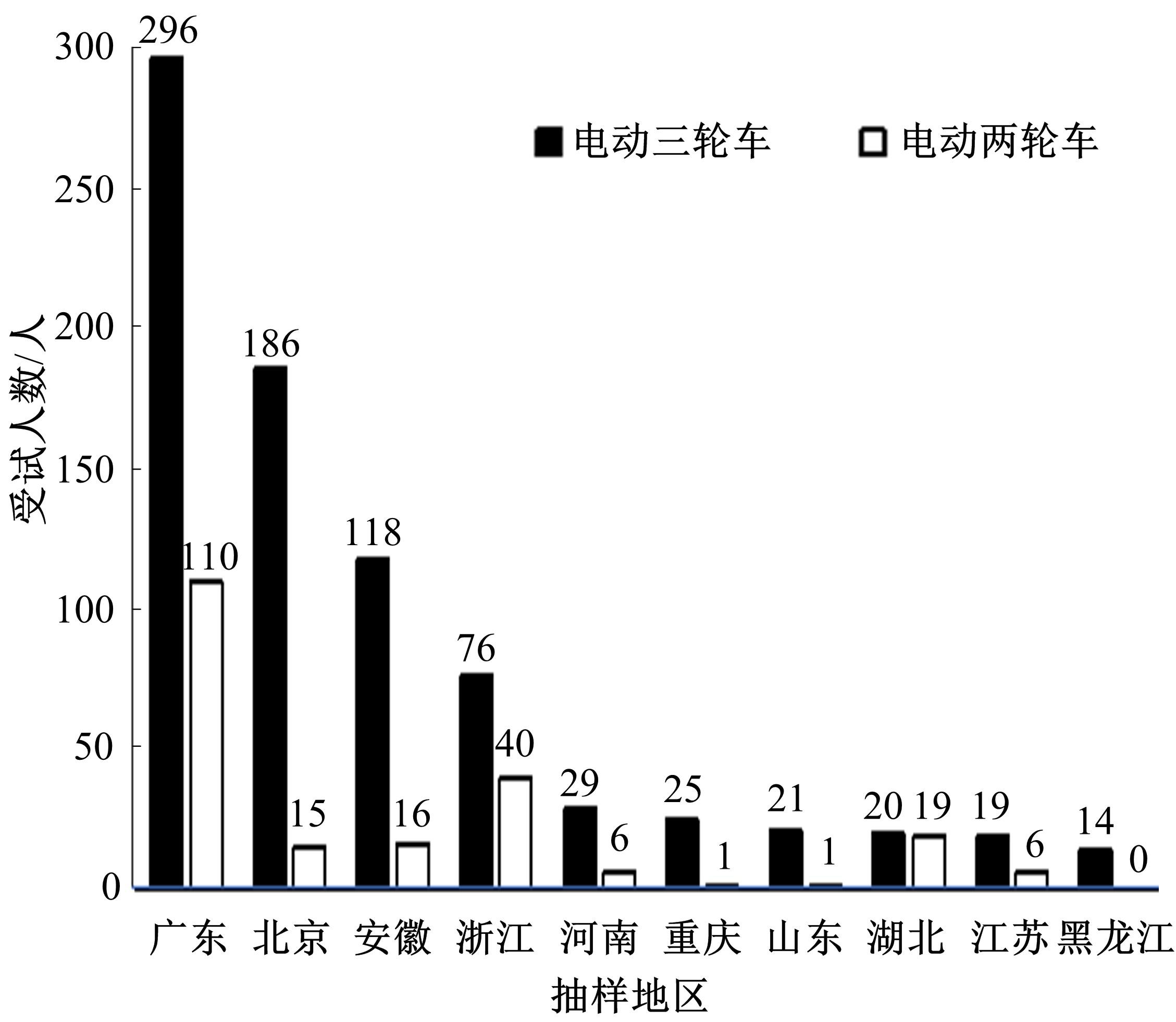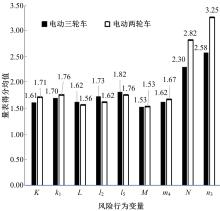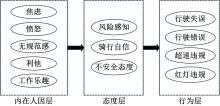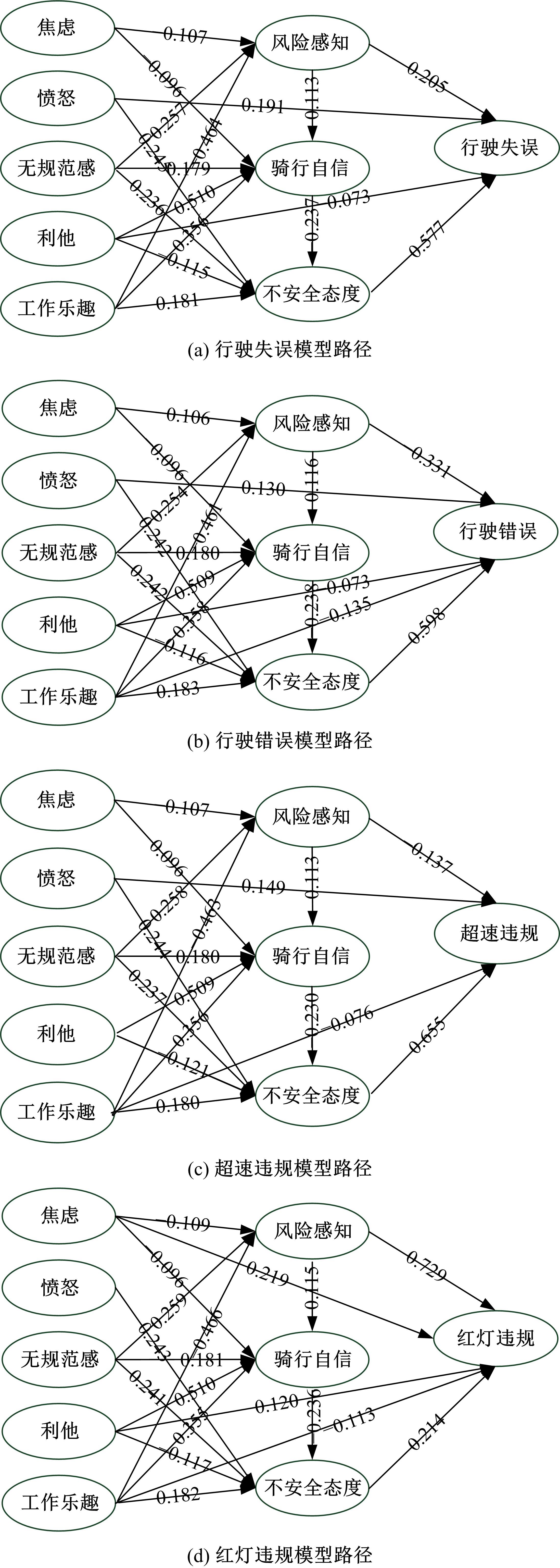Journal of Jilin University(Engineering and Technology Edition) ›› 2023, Vol. 53 ›› Issue (2): 413-420.doi: 10.13229/j.cnki.jdxbgxb20210707
Previous Articles Next Articles
Risk behaviors and influencing factors of cargo electric tricycles
Yi HE1,2( ),Chang-xin SUN1,2,Jian-hua PENG3,Chao-zhong WU1,2,Liang JIANG4,Ming MA5
),Chang-xin SUN1,2,Jian-hua PENG3,Chao-zhong WU1,2,Liang JIANG4,Ming MA5
- 1.Intelligent Transportation Systems Research Center,Wuhan University of Technology,Wuhan 430063,China
2.Engineering Research Center of Waterway and Highway Traffic Safety Control and Equipment,Ministry of Education,Ministry of Education,Wuhan University of Technology,Wuhan 430063,China
3.China Academy of Transportation Sciences,Ministry of Transport,Beijing 100029,China
4.China Transport Telecommunications & Information Center,Ministry of Transport,Beijing 100011,China
5.Department of Transport Services,Ministry of Transport,Beijing 100736,China
CLC Number:
- U491.254
| 1 | 傅志寰, 孙永福, 翁孟勇, 等. 交通强国战略研究[M]. 北京: 人民交通出版社, 2019. |
| 2 | 严新平, 吴兵, 贺宜, 等. 我国零死亡愿景交通安全理念[J]. 交通信息与安全, 2019(1): 1-6. |
| Yan Xin-ping, Wu Bing, He Yi, et al. A study of "Version Zero" concept of transportation safety and its implementation strategies in China[J]. Journal of Transport Information and Safety, 2019(1): 1-6. | |
| 3 | 第一物流研究院. 电动三轮车在快递行业使用情况报告[R]. 北京: 现代物流报, 2016. |
| 4 | Zhang G, Yau K K W, Chen G. Risk factors associated with traffic violations and accident severity in China[J]. Accident Analysis & Prevention, 2013, 59: 18-25. |
| 5 | Vlahogianni E I, Yannis G, Golias J C. Overview of critical risk factors in power-two-wheeler safety[J]. Accident Analysis & Prevention, 2012, 49: 12-22. |
| 6 | Johnson P, Brooks C, Savage H. Fatal and Serious Road Crashes Involving Motorcyclists[M]. Australia: Department of Infrastructure, Transport, Regional Development and Local Government, 2008. |
| 7 | Zambon F, Hasselberg M. Factors affecting the severity of injuries among young motorcyclists-a Swedish nationwide cohort study[J]. Traffic Injury Prevention, 2006, 7: 143-149. |
| 8 | 江亮, 贺宜. 电动两轮车风险驾驶行为及事故影响因素分析[J]. 吉林大学学报: 工学版, 2019, 49(4): 1107-1113. |
| Jiang Liang, He Yi. Risky driving behavior and influencing factors for electric two-wheeler[J]. Journal of Jilin University(Engineering and Technology Edition), 2019, 49(4): 1107-1113. | |
| 9 | Reason J, Manstead A, Stradling S, et al. Errors and violations on the roads: a real distinction?[J]. Ergonomics, 1990, 33(10/11): 1315-1332. |
| 10 | Westerman S J, Haigney D. Individual differences in driver stress, error and violation[J]. Personality and Individual Differences, 2000, 29(5): 981-998. |
| 11 | Chen C. Personality, safety attitudes and risky driving behaviors—evidence from young Taiwanese motorcyclists[J].Accident Analysis & Prevention, 2009, 41(5): 963-968. |
| 12 | Wang C, Xu C, Xia J, et al. The effects of safety knowledge and psychological factors on self-reported risky driving behaviors including group violations for e-bike riders in China[J]. Transportation Research Part F: Traffic Psychology and Behaviour, 2018, 56: 344-353. |
| 13 | Ulleberg P, Rundmo T. Personality, attitudes and risk perception as predictors of risky driving behaviour among young drivers[J]. Safety Science, 2003, 41(5): 427-443. |
| 14 | Starkey N J, Isler R B.The role of executive function, personality and attitudes to risks in explaining self-reported driving behaviour in adolescent and adult male drivers[J].Transportation Research Part F:Traffic Psychology and Behaviour,2016,38:127-136. |
| 15 | Yao L, Wu C. Traffic safety for electric bike riders in china: attitudes, risk perception, and aberrant riding behaviors[J]. Transportation Research Record: Journal of the Transportation Research Board, 2012, 2314(1): 49-56. |
| 16 | Mallia L, Lazuras L, Violani C, et al. Crash risk and aberrant driving behaviors among bus drivers: the role of personality and attitudes towards traffic safety[J]. Accident Analysis & Prevention, 2015, 79: 145-151. |
| 17 | Wong J, Chung Y, Huang S. Determinants behind young motorcyclists' risky riding behavior[J]. Accident Analysis & Prevention, 2010, 42(1): 275-281. |
| 18 | Johnson J A. Measuring thirty facets of the five factor model with a 120-item public domain inventory: development of the IPIP-NEO-120[J]. Journal of Research in Personality, 2014(51): 78-89. |
| 19 | Goldbery L R. The development of markers for the big-five factor structure[J]. Psychological Assessment, 1992, 4(1): 26-42. |
| 20 | Anderson J C, Gerbing D W. Structural equation modeling in practice: a review and recommended two-step approach[J]. Psychological Bulletin, 1988, 103(3): 411-423. |
| 21 | 秦浩, 陈景武. 结构方程模型原理及其应用注意事项[J]. 中国卫生统计, 2006(4): 367-369. |
| Qin Hao, Chen Jing-wu. Principles and application considerations of structural equation model[J]. Chinese Journal of Health Statistics, 2006(4): 367-369. | |
| 22 | Hooper D, Coughlan J, Mullen M R. Structural equation modelling: guidelines for determining model fit[J]. Electronic Journal of Business Research Methods, 2008, 1(6): 53-60. |
| 23 | Papantoniou P, Antoniou C, Yannis G, et al. Which factors affect accident probability at unexpected incidents? A structural equation model approach[J]. Journal of Transportation Safety & Security, 2019, 11(5): 544-561. |
| 24 | 吴超仲, 万平, 张晖, 等. 交通从众行为研究——机遇与挑战[J]. 交通信息与安全, 2013, 31(2): 1-5. |
| Wu Chao Zhong, Wan Ping, Zhang Hui, et al. Traffic conformity behavior research—opportunity and challenge[J]. Journal of Transport Information and Safety, 2013, 31(2): 1-5. | |
| 25 | 董春娇,董黛悦,诸葛承祥,等.电动自行车出行特性及骑行决策行为建模[J].吉林大学学报:工学版,2022, 52(11): 2618-2625. |
| Dong Chun-jiao, Dong Dai-yue, Cheng-xiang Zhu-ge, et al. Trip characteristics and decision⁃making behaviors modeling of electric bicycles riding[J]. Journal of Jilin University(Engineering and Technology Edition), 2022, 52(11): 2618-2625. |
| [1] | Jie-yu ZHU,Yan-li MA. Real-time risk assessment method of multi-vehicle interaction at merging area [J]. Journal of Jilin University(Engineering and Technology Edition), 2022, 52(7): 1574-1581. |
| [2] | Liang JIANG,Yi HE. Risky driving behavior and influencing factors analysis for electric two⁃wheeler [J]. Journal of Jilin University(Engineering and Technology Edition), 2019, 49(4): 1107-1113. |
| [3] | DAI Cun-jie,LI Yin-zhen,MA Chang-xi,CHAI Huo,MU Hai-bo. Multi-criteria optimization for hazardous materials distribution routes under uncertain conditions [J]. Journal of Jilin University(Engineering and Technology Edition), 2018, 48(6): 1694-1702. |
| [4] | HOU Xian-yao, CHEN Xue-wu. Use of public transit information market segmentation based onattitudinal factors [J]. 吉林大学学报(工学版), 2018, 48(1): 98-104. |
| [5] | SUN Lu, XU Jian, CUI Xiang-min. Panel data models for analysis and prediction of crash count [J]. 吉林大学学报(工学版), 2015, 45(6): 1771-1778. |
| [6] | XU Jian, SUN Lu. Modeling of excess zeros issue in crash count andysis [J]. 吉林大学学报(工学版), 2015, 45(3): 769-775. |
| [7] | JIN Li-sheng, WANG Yan, LIU Jing-hua, WANG Ya-li, ZHENG Yi. Front vehicle detection based on Adaboost algorithm in daytime [J]. 吉林大学学报(工学版), 2014, 44(6): 1604-1608. |
| [8] | JIN Li-sheng,NIU Qing-ning,LIU Jing-hua,QIN Yan-guang,YU Huan-huan. Driver cognitive distraction detection in different road lines [J]. 吉林大学学报(工学版), 2014, 44(3): 642-647. |
| [9] | ZHAN Wei, LYU Qing, SHANG Yue-quan. Analysis of gray-Markov forecasting for traffic accidents in highway tunnel group region [J]. 吉林大学学报(工学版), 2014, 44(01): 62-67. |
| [10] | JIN Li-sheng| FANG Wen-ping, HOU Hai-jing, SUN Yu-qin. Co-simulation of lane keeping control system based on BP neural network [J]. 吉林大学学报(工学版), 2010, 40(03): 650-0654. |
| [11] | JIN Li-sheng, BART van Arem,YANG Shuang-bin1, MASCHA van der Voort,MARTIJN Tideman . Safety lane change model of vehicle assistant driving on highway [J]. 吉林大学学报(工学版), 2009, 39(03): 582-0586. |
| [12] | Zhang Fei-jun,Wang Yun-peng,Shi Shu-ming,Li Shi-wu,Sun Fu-shen, Wang Bin-bin . Simulation of road alignment design safety evaluation [J]. 吉林大学学报(工学版), 2007, 37(03): 528-0532. |
| [13] | Tian Jian, Li Jiang, Li Yaqiao. Calibration technique of photogrammetry of traffic accident scene [J]. 吉林大学学报(工学版), 2006, 36(增刊1): 136-0139. |
| [14] | Wang Yunpeng, Yang Zhifa, Li Shiwu, Wang Junli. Quantitative Assessment of Influence of Traffic Environment on Road Safety [J]. 吉林大学学报(工学版), 2006, 36(01): 119-0122. |
|







